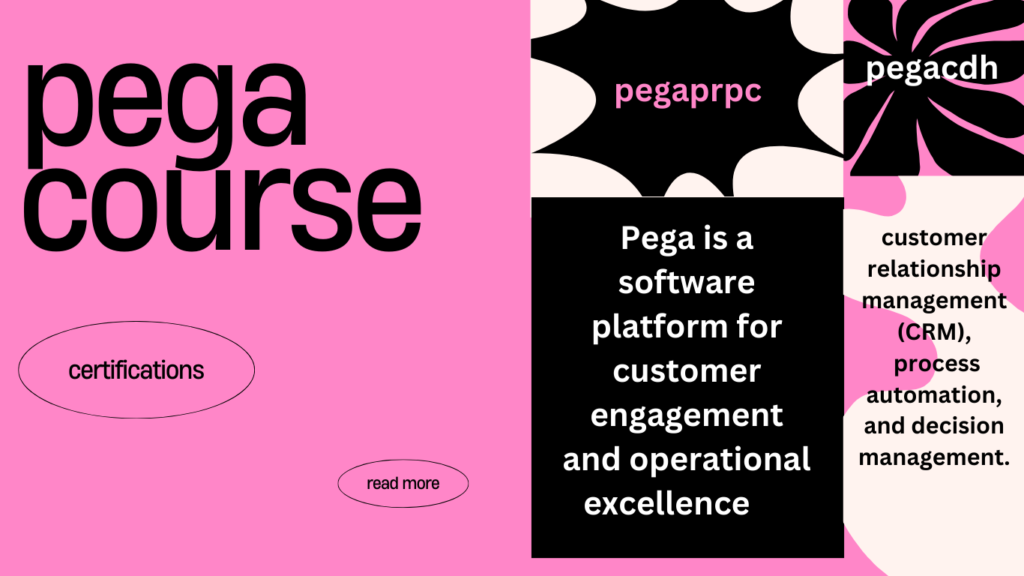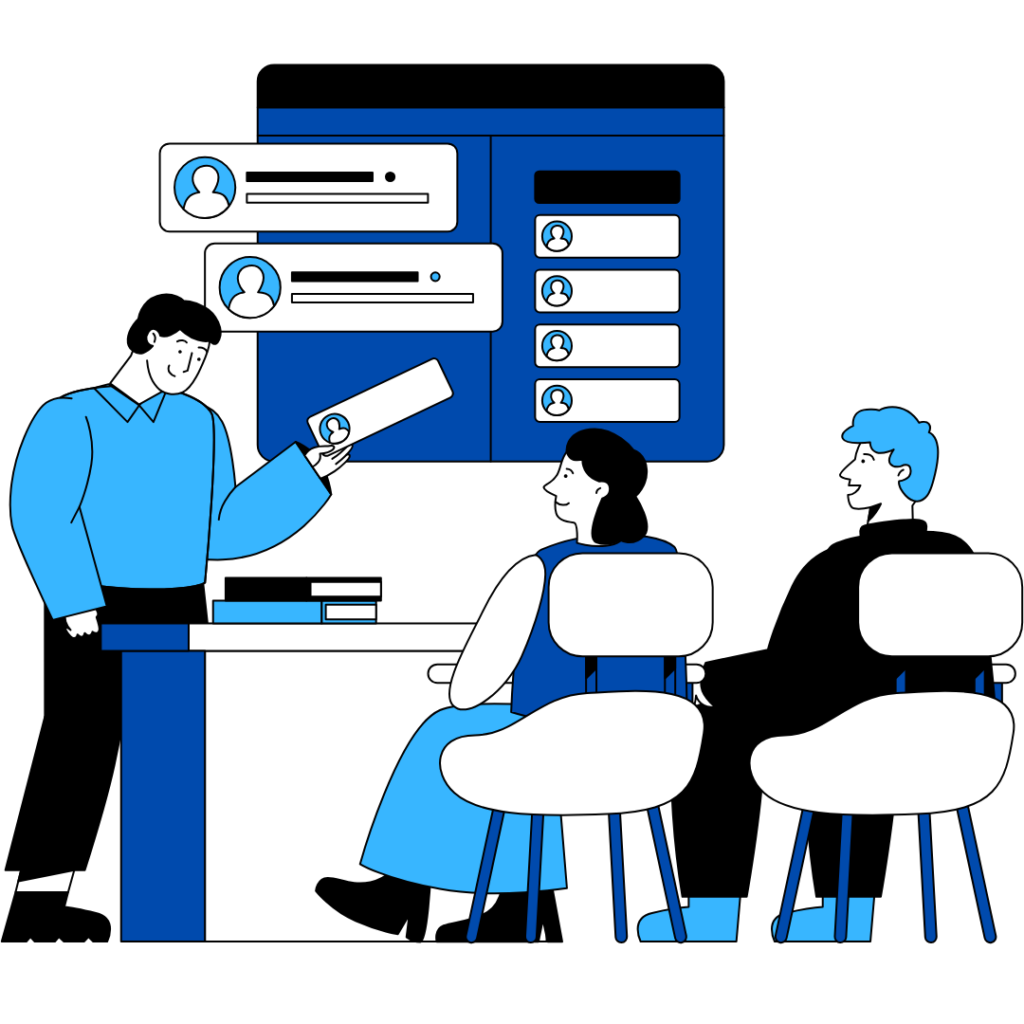What is the Pega Training
Introduction to Pega Training
What is Pega Training is a leading provider of BPM (Business Process Management) and CRM (Customer Relationship Management) software solutions. The Pega Training platform enables organizations to build, deploy, and manage enterprise-level applications for various Pega Training business processes, including customer service, marketing, sales, and operations.
What is the Pega Training is a leading software platform that empowers enterprises to streamline operations and enhance customer engagement. Offering robust features like AI, RPA, and omnichannel capabilities enables businesses to automate processes, predict customer behavior, and deliver personalized experiences across various industries.
Its low-code development approach facilitates rapid application development, fostering collaboration between business users and developers. Pega training excels in case management, orchestrating complex workflows, and ensuring efficient resolution. Pega training, which emphasizes digital transformation, security, and compliance, enables businesses to grow, adapt, and prosper in the fast-paced business environment of today while boosting customer satisfaction and operational excellence.

Pega Training Overview:
what is the Pega Training offers a comprehensive set of training courses designed to equip developers, architects, business analysts, and system administrators with the skills and knowledge needed to leverage the full potential of the Pega platform. These pega trainings cover various aspects of training in the development, pegafiguration, and implementation aspects, catering to roles and proficiency levels.
What is the Pega training Content:
Pega training typically covers the following key topics:
1. Introduction to Pega Platform: An overview of the Pega platform architecture, features, and capabilities.
2. Pega Application Development: Training on building and What is the Pega Training customizing Pega applications using Pega’s low-code development tools.
3. Pega Case Management: Understanding how to design and implement case management solutions using Pega’s framework.
4. Pega User Interface (UI) Development: Learning to create intuitive and user-friendly UIs for Pega applications using Pega’s UI technologies.
5. Pega Integration: Training on integrating Pega applications with external systems and services using various integration methods and protocols.
6. Pega Decisioning: Understanding how to incorporate decision-making capabilities into Pega applications using Pega’s decision management tools.
7. Pega Administration: Training on administering and managing Pega training environments, including installation, configuration, and Pega training monitoring.
8. Pega Agile Methodology: Learning to apply Agile principles and practices to Pega application development projects.

Certifications:
Pega Training Certification Procedure
Introduction
Pega Systems Inc. is a leader in software for customer engagement and operational excellence. Organizations use Pega’s applications to optimize customer interactions, automate business processes, and enhance decision-making. Pega’s certification program aims to validate the skills and knowledge of professionals working with Pega’s software solutions. This guide outlines the certification procedure, including preparation, available certifications, and the examination process.
1. Understanding Pega Certifications
1.1 Types of Certifications
Pega offers a range of certifications tailored to different roles and levels of expertise. These include:
- System Architect Certification:
- Certified System Architect (CSA)
- Certified Senior System Architect (CSSA)
- Lead System Architect (LSA)
- Business Architect Certification:
- Certified Pega Business Architect (CPBA)
- Decisioning Consultant Certification:
- Certified Decisioning Consultant (CDC)
- Marketing Consultant Certification:
- Certified Pega Marketing Consultant (CPMC)
- Robotic Automation Certification:
- Certified Robotics System Architect (CRSA)
- Data Scientist Certification:
- Certified Data Scientist (CDS)
1.2 Certification Pathways
Each certification follows a structured pathway starting from basic to advanced levels:
- CSA: Entry-level certification for system architects, focusing on Pega platform basics and application development.
- CSSA: Intermediate certification for experienced system architects, focusing on advanced application development and performance tuning.
- LSA: Advanced certification for lead system architects, focusing on large-scale, complex application design and enterprise-level architecture.
2. Preparing for Certification
2.1 Prerequisite Knowledge
Before pursuing Pega certifications, it’s crucial to have a foundational understanding of software development, business processes, and Pega’s platform. Here are the prerequisites for key certifications:
- CSA: Basic knowledge of software development and business processes.
- CSSA: CSA certification and practical experience in Pega application development.
- LSA: CSSA certification and extensive experience in Pega application development and architecture.
2.2 Training Resources
Pega provides a variety of training resources to prepare for certifications:
- Pega Academy: The primary learning platform offering courses, hands-on exercises, and practice exams.
- Instructor-Led Training: Available for certain courses, offering guided learning from Pega experts.
- Community Resources: Discussion forums, webinars, and study groups.
2.3 Study Materials
For each certification, Pega Academy provides specific study materials, including:
- Course Modules: Comprehensive lessons covering exam topics.
- Exercise Guides: Step-by-step guides for hands-on practice.
- Sample Questions: Practice questions to familiarize with the exam format.
- Study Plans: Recommended study plans and timelines.
3. Registration Process
3.1 Creating a Pega Account
To begin the certification process, create an account on Pega Academy:
- Visit Pega Academy: Go to the Pega Academy website.
- Sign Up: Complete the registration form with your personal and professional details.
- Verify Email: Confirm your email address through the verification link sent by Pega Academy.
3.2 Enrollment in Courses
After creating an account, enroll in the relevant courses:
- Browse Courses: Explore the catalog of available courses.
- Select Course: Choose the course aligned with your certification goal.
- Enroll: Click the enroll button and follow the prompts to start the course.
3.3 Scheduling the Exam
Once prepared, schedule your exam:
- Login to Pega Academy: Access your account.
- Navigate to Certification: Go to the certification section.
- Choose Certification: Select the desired certification exam.
- Schedule Exam: Follow the instructions to schedule the exam date, time, and testing center (or choose online proctored option).
- Pay Exam Fee: Complete the payment process. Fees vary based on certification level.
4. Examination Process
4.1 Exam Format
Pega certification exams typically consist of:
- Multiple Choice Questions (MCQs)
- Scenario-Based Questions
- Practical Exercises (for advanced certifications)
4.2 Online Proctoring
For convenience, Pega offers online proctored exams:
- System Requirements: Ensure your computer meets the technical requirements.
- Secure Environment: Prepare a quiet, private space free from interruptions.
- Identity Verification: Provide valid identification and follow the proctor’s instructions.
4.3 Exam Day Tips
- Rest Well: Ensure you are well-rested and alert.
- Review Key Concepts: Go through your notes and key concepts.
- Check System: Test your computer and internet connection.
- Be Punctual: Log in at least 15 minutes before the scheduled time.
4.4 Exam Scoring
- Passing Score: Typically, a score of 65-70% is required to pass.
- Immediate Results: Results are usually available immediately after the exam.
- Detailed Feedback: Receive a breakdown of your performance in different sections.
5. Post-Certification
5.1 Certification Validity
Pega certifications are typically valid for two years. To maintain your certification:
- Stay Updated: Keep up with the latest Pega platform updates.
- Recertification: Complete recertification requirements before the expiration date.
5.2 Career Advancement
Pega certifications can significantly enhance your career prospects:
- Increased Job Opportunities: Access to a wider range of job roles.
- Higher Salary: Certified professionals often command higher salaries.
- Professional Recognition: Gain recognition as a Pega expert in your organization and industry.
5.3 Continuing Education
To further advance your skills and career, consider:
- Advanced Certifications: Pursue higher-level certifications.
- Specialized Training: Enroll in specialized courses on Pega Academy.
- Community Involvement: Participate in Pega forums, events, and webinars.
6. Conclusion
Achieving Pega certification is a valuable investment in your professional development. By following the outlined procedure, from understanding the types of certifications to preparing effectively and successfully passing the exam, you can enhance your skills, advance your career, and become a recognized expert in Pega’s powerful software solutions.
This guide should provide a comprehensive overview of the Pega Training certification procedure, helping you navigate each step effectively and confidently.
Pegatraining certifications play a crucial role in validating the expertise and proficiency of individuals working with the Pega training platform. Certified System Architect (CSA) certification serves as an entry point for beginners, covering essential concepts of Pega trainingapplication development. Certified Decisioning Consultant (CDC) certification focuses on decision-making capabilities, catering to professionals specializing in decision-making and analytics. PRPC certifications, despite the name change to Pegatraining Platform, remain relevant and valuable for individuals seeking recognition in Pegatraining application development.
Pega offers a range of certifications for individuals looking to validate their expertise and proficiency in using the Pega platform. These certifications are recognized globally and are highly regarded by organizations using Pega software. Some of the popular Pega training &certifications include: Certainly! Let’s provide a brief introduction to some of the key Pega training &certifications:

1. Certified System Architect (CSA):
The Certified System Architect (CSA) certification is an entry-level certification offered by Pega training. It validates the candidate’s ability to build and implement basic Pega applications. CSA certification covers fundamental concepts of Pega training application development, including case design, data modeling, user interface development, and integration. It is an essential certification for What is the Pega Training individuals starting their journey in Pega development.
2. PRPC (Pegarules training Commander):
PRPC, which stands for PegaRULES Process Commander, is the former name of the Pega platform. Pega has developed a comprehensive software solution for business process management (BPM) and customer relationship management (CRM). PRPC provides a platform for building, deploying, and managing enterprise-level applications for various business processes. Although the name has been phased out, PRPC certifications are still relevant and widely recognized in the Pega c.
3. Certified Pega Developer (CPD): This certification validates the developer’s ability to effectively design, build, and deploy Pega applications. It covers various aspects of Pega application development, including case design, data modeling, UI development, integration, and debugging.
4. Certified Senior System Architect (CSSA): This certification is designed for experienced developers who deeply understand Pega application development concepts and best practices. It validates the developer’s proficiency in building complex Pega applications and solutions.
5. The highest credential given by Pega is the Certified Lead System Architect (CLSA), which is intended for seasoned Pega professionals with a wealth of knowledge in the design and implementation of enterprise-level Pega solutions. They are implementing enterprise-level Pega solutions. CLSA certification candidates must demonstrate advanced knowledge and skills in various areas, including architecture, design patterns, performance optimization, and team leadership.
4. Certified Business Architect (CBA): This certification is intended for business analysts and architects who are vital in defining and shaping Pega application requirements and solutions. It validates the candidate’s ability to effectively gather, analyze, and document business requirements and translate them into Pega application designs.
5. Certified Decisioning Consultant (CDC): This certification focuses on Pega’s decision-management capabilities and is aimed at professionals specializing in designing and implementing decision-making solutions using Pega’s decision-management tools.
The Certified Decisioning Consultant (CDC) certification focuses on Pega’s decision-making capabilities. It validates the candidate’s proficiency in designing and implementing decision-making solutions using Pega’s decision-management tools. CDC certification covers predictive analytics, adaptive decision-making, and real-time decision-making. It is ideal for professionals specializing in decisioning and analytics within Pega applications.

Key Terminology:
Here are some essential Pega terminologies that newly created developers should be familiar with:
1. Case: In Pega, a case represents a unit of work or a business process initiated and managed within a Pega application. Cases can be simple or complex, involving multiple steps, stages, and interactions with users and systems.
2. Flow: In Pega, a flow represents the sequence of steps or actions needed to complete a case or a business process. Depending on the complexity of the process, flows can be linear or branched.
3. Assignment: In Pega, an assignment represents a task or work item assigned to a user or a group of users for action. Assignments can be manual or automated, driving the progression of cases through various stages.
4. Harness: A harness in Pega training defines the layout and structure of user interfaces (UIs) within a Pega application. It determines how information is presented to users and how they interact with the application.
5. Integration: Integration in Pega training refers to connecting Pega training applications with external systems, services, or data sources. Pega supports various integration methods, including REST, SOAP, and messaging, to enable seamless communication between different systems.
6. Data Model: The data model in Pega training defines the structure and relationships of data entities within a Pega application. It includes classes, properties, and relationships that govern how the application stores, retrieves and manipulates data.
7. Rule: A rule in Pega training represents a reusable component or configuration element that defines the behavior or functionality of a Pega application. Rules can include UI components, decision rules, data transforms, and more.
8. Activity: An activity in Pega represents a sequence of steps or actions executed to perform a specific task or operation within a Pega application. Activities can be invoked from various points within the application to automate business logic and processes.
Considerations for Newly Created Developers:
For newly created developers entering the world of Pega development, here are some important considerations:
1. Training and Education: Invest time in completing Pega training and obtaining relevant certifications to build a strong foundation for developing concepts and best practices.
2. Hands-on Experience: Gain practical experience by working on real-world Pega training projects and assignments. This will help you apply theoretical knowledge practically and enhance your skills.
3. Continuous Learning: Stay updated with the latest advancements and updates on the Pega platform by actively participating in forums, communities, and training programs. Continuous learning is essential to keeping pace with evolving technology trends.
4. Collaboration and Networking: Collaborate with experienced Pega training professionals and participate in knowledge-sharing activities to expand your network and learn from others’ experiences.
5. Problem-solving Skills: Develop strong problem-solving skills to troubleshoot and resolve Pega training application development and deployment issues effectively.
By focusing on these considerations and leveraging the available resources and support from the Pega training community, newly created developers can accelerate their learning journey and become proficient Pega practitioners.
This overview should give you a solid understanding of Pega training, certifications, key terminologies, and considerations for newly created developers. Let me know if you need further details or have any specific questions!
These certifications offer a pathway for individuals to enhance their skills, expand their knowledge, and advance their careers in Pega training development and implementation. Whether you’re new to Pega raining or looking to specialize in a specific area, pursuing Pega certifications can give you the validation and recognition you need to succeed in the industry.

For more information and job related please visit alljobsinfo.net
Pega Question and Answers
- What is Pega?
Pega is a software platform for customer engagement and operational excellence. It provides tools for building, deploying, and managing enterprise applications. - What are Pega’s key features?
Pega offers case management, business process management, customer relationship management, artificial intelligence, robotic process automation, and omnichannel capabilities. - How does Pega utilize artificial intelligence?
Pega uses AI to automate and optimize business processes, predict customer behavior, personalize customer interactions, and provide real-time decision support. - What industries use Pega software?
Pega is used across various sectors, including banking, insurance, healthcare, telecommunications, retail, and government. - What is Pega’s role in digital transformation?
Pega training helps organizations digitally transform by streamlining processes, improving customer experiences, and enabling agile and adaptive operations. - Can Pega integrate with other systems?
Yes, through APIs, connectors, and adaptors, Pega provides integration capabilities with legacy systems, third-party applications, and emerging technologies. - What is Pega’s approach to customer engagement?
Pega offers a unified platform for orchestrating customer journeys across multiple channels, ensuring consistent and personalized experiences. - How does Pega support case management?
Pega’s case management capabilities enable organizations to efficiently manage and resolve complex cases by automating workflows, assigning tasks, and tracking progress. - What is Pega’s low-code development approach?
Pega’s low-code platform allows business users and developers to collaborate in building and customizing applications using visual tools and pre-built components, reducing time-to-market and development costs. - How does Pega ensure security and compliance?
Pega adheres to industry standards and best practices for security and compliance, including data encryption, access controls, audit trails, and regulatory certifications. Additionally, Pega provides tools for monitoring and enforcing security policies within applications.
